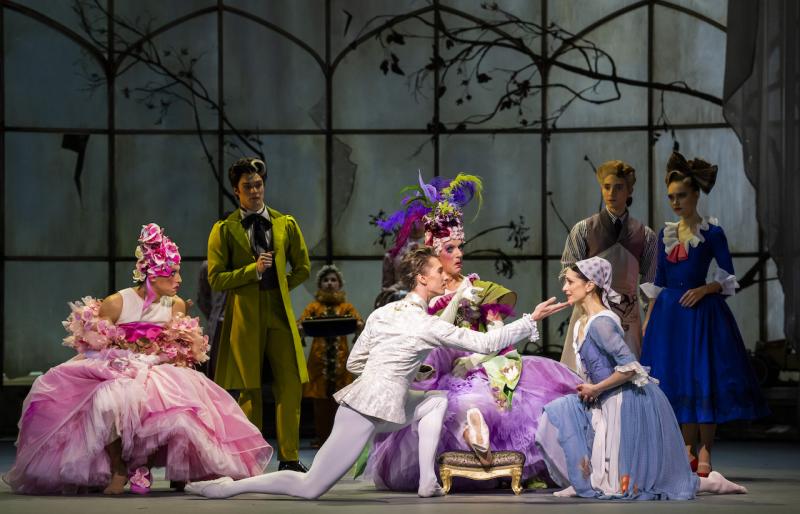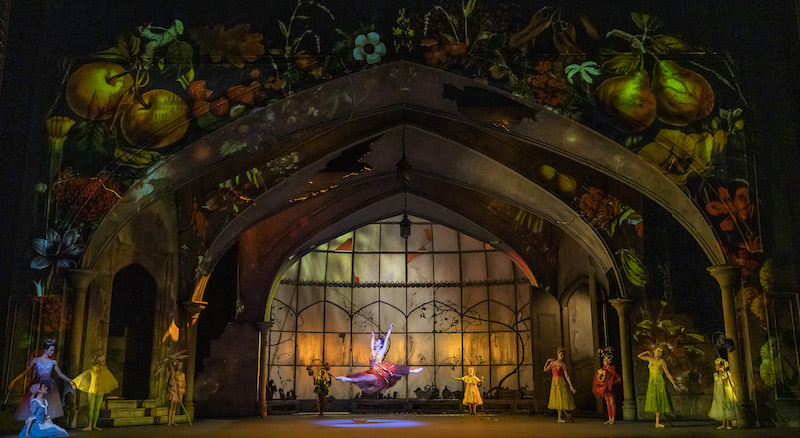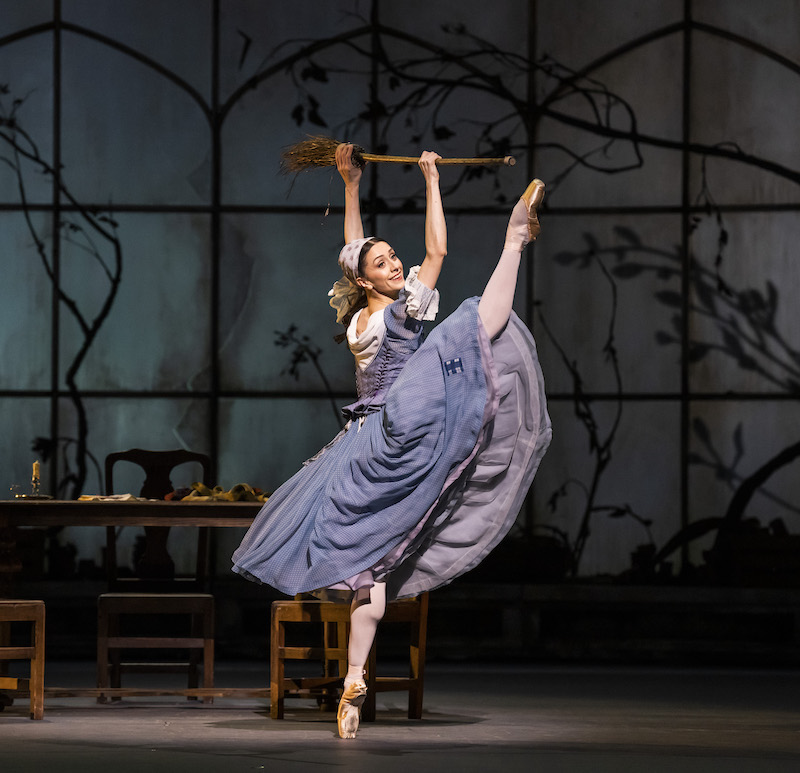Cinderella, Royal Ballet review - the first British ballet learns the language of flowers | reviews, news & interviews
Cinderella, Royal Ballet review - the first British ballet learns the language of flowers
Cinderella, Royal Ballet review - the first British ballet learns the language of flowers
Plant life blooms everywhere you look in Frederick Ashton's earliest full-evening ballet

The urge to redesign a heritage ballet is a curious one, given not just the expense but the fact that the main draw of an old ballet is the steps and the music, which stay the same whatever the stage dressing.
The opening scene may begin familiarly around the hearth of a grand if dilapidated family home, (design by Tom Pye, best known for his TV work on Gentleman Jack), but with the arrival of the fairy godmother the outdoor world starts to intrude. Great cracks appear in the plaster allowing greenery to burst through, which then runs through its cycle of fruiting and seeding as the four fairies of the seasons work their spells in turn. Finn Ross’s luscious video projections would benefit from quieter stage machinery, though. The clatter of opening flaps and sliding screens diminished the magic on opening night but the visuals are extraordinary indeed.
 They also help make sense of the four Seasons’ solos prescribed by Prokofiev’s score, which in some productions can seem a narrative distraction. Fairy Spring (Anna Rose O’Sullivan on opening night) is all fast, sharp flickerings, her hands mimicking the bursting of buds. Summer (Melissa Hamilton) is warm and languorous, Autumn (Yuhui Choe, pictured above) a gust of wind that blows the walls away, while Winter causes the window glass to crack apart revealing Mayara Magri in a glitter of ice, repeatedly switching direction on the point of one toe. Ashton was famously hard on his dancers, pushing them to the limits of technique. I could have done without the added Flower Fairy children, who had been given nothing more to do than stand holding outsize stems: one botanical idea too many.
They also help make sense of the four Seasons’ solos prescribed by Prokofiev’s score, which in some productions can seem a narrative distraction. Fairy Spring (Anna Rose O’Sullivan on opening night) is all fast, sharp flickerings, her hands mimicking the bursting of buds. Summer (Melissa Hamilton) is warm and languorous, Autumn (Yuhui Choe, pictured above) a gust of wind that blows the walls away, while Winter causes the window glass to crack apart revealing Mayara Magri in a glitter of ice, repeatedly switching direction on the point of one toe. Ashton was famously hard on his dancers, pushing them to the limits of technique. I could have done without the added Flower Fairy children, who had been given nothing more to do than stand holding outsize stems: one botanical idea too many.
Not so Alexandra Byrne’s costuming of the stepsisters as hothouse flowers, forced, garish and behaviourally odd. Gary Avis is obvious casting for the tall, bossy one, but Luca Acri is a revelation as her shyer, dimmer sibling – the role Ashton made his own to the delight of audiences in the 1950s and 60s. Later in the run two female character-dancers will take these roles, and it will be interesting to see how the comedy stands up to the change. Have pantomime dames with their pratfalls and over-egging had their day? Watching Avis and Acri, excellent both, I suspect that they have, in an age when Ru Paul’s Drag Race is standard daytime fare.
 The real key to Cinderella the ballet is of course the playing of the title role, and there was never any doubt that Marienela Nuñez (pictured above) would take the first-night honours. Ashton would have adored this dancer with her small, neat features, her pliant torso, exceptional musicality and exquisite feet. It’s hard to think of another ballerina who would prompt the lifting of so many opera glasses on her opening solo, a display of oh-so-precisely placed footwork by a girl who has been raised for better things but is forced to live as a scullery maid. If there was an audible sigh as she danced I was partly responsible.
The real key to Cinderella the ballet is of course the playing of the title role, and there was never any doubt that Marienela Nuñez (pictured above) would take the first-night honours. Ashton would have adored this dancer with her small, neat features, her pliant torso, exceptional musicality and exquisite feet. It’s hard to think of another ballerina who would prompt the lifting of so many opera glasses on her opening solo, a display of oh-so-precisely placed footwork by a girl who has been raised for better things but is forced to live as a scullery maid. If there was an audible sigh as she danced I was partly responsible.
The other major component of this ballet is Prokofiev’s score which, however many times you’ve heard it, is startling for its mournfulness, its insistent minor key and preponderance of lower strings and horns. I liked the way the Act I designs picked up on this – dead branches silhouetted against the drawing-room window, the beggar-woman a dark lacy blur like a dessecated hydrangea. Not until Cinderella arrives in splendour at the ball does the music lighten into not one but two glittering waltzes as the action hurtles towards midnight.
At this point I take issue with just one design detail. The ballroom act is otherwise magnificent, the guests tricked out like so many blooms in a rose garden, courtesy of Dior’s New Look – all the rage the year Ashton choreographed this ballet. My gripe is with the ormolu clock on the front elevation of the palace, its hands permanently set at 10 to 12. We all know the significance of midnight. Prokofiev did too: in his original scenario he prescribed 12 tap-dancing dwarves leaping out of the clock (to the sinister beat of the wood block, which remains in the score, followed by sinister dissonances from lower brass between the 12 chimes). Dwarves or no dwarves, it’s a critical moment, undermined in this case by a stage clock that clearly tells us the wrong time. Given the technical ingenuity employed elsewhere in this production, could not someone have installed a battery job to set this right?
Despite this minor flaw, as well as a pumpkin transformation that's frankly underweight, it’s a real achievement that the visual effects feel magical rather than digital. Film can do digital but live theatre and dance should steer clear of it, or risk losing their raison d’être. Hats off to conductor Koen Kessel for leading the House orchestra through a reading of Prokofiev’s score that skimped not a molecule of its darkness, nor its glistening enchantment.
- Cinderella, in rep at the Royal Opera House until 3 May
- Live screened to selected cinemas 12 April
- More dance reviews on theartsdesk
rating
Explore topics
Share this article
Add comment
The future of Arts Journalism
You can stop theartsdesk.com closing!
We urgently need financing to survive. Our fundraising drive has thus far raised £49,000 but we need to reach £100,000 or we will be forced to close. Please contribute here: https://gofund.me/c3f6033d
And if you can forward this information to anyone who might assist, we’d be grateful.

Subscribe to theartsdesk.com
Thank you for continuing to read our work on theartsdesk.com. For unlimited access to every article in its entirety, including our archive of more than 15,000 pieces, we're asking for £5 per month or £40 per year. We feel it's a very good deal, and hope you do too.
To take a subscription now simply click here.
And if you're looking for that extra gift for a friend or family member, why not treat them to a theartsdesk.com gift subscription?
more Dance
 'We are bowled over!' Thank you for your messages of love and support
Much-appreciated words of commendation from readers and the cultural community
'We are bowled over!' Thank you for your messages of love and support
Much-appreciated words of commendation from readers and the cultural community
 Peaky Blinders: The Redemption of Thomas Shelby, Rambert, Sadler's Wells review - exciting dancing, if you can see it
Six TV series reduced to 100 minutes' dance time doesn't quite compute
Peaky Blinders: The Redemption of Thomas Shelby, Rambert, Sadler's Wells review - exciting dancing, if you can see it
Six TV series reduced to 100 minutes' dance time doesn't quite compute
 Giselle, National Ballet of Japan review - return of a classic, refreshed and impeccably danced
First visit by Miyako Yoshida's company leaves you wanting more
Giselle, National Ballet of Japan review - return of a classic, refreshed and impeccably danced
First visit by Miyako Yoshida's company leaves you wanting more
 Quadrophenia, Sadler's Wells review - missed opportunity to give new stage life to a Who classic
The brilliant cast need a tighter score and a stronger narrative
Quadrophenia, Sadler's Wells review - missed opportunity to give new stage life to a Who classic
The brilliant cast need a tighter score and a stronger narrative
 The Midnight Bell, Sadler's Wells review - a first reprise for one of Matthew Bourne's most compelling shows to date
The after-hours lives of the sad and lonely are drawn with compassion, originality and skill
The Midnight Bell, Sadler's Wells review - a first reprise for one of Matthew Bourne's most compelling shows to date
The after-hours lives of the sad and lonely are drawn with compassion, originality and skill
 Ballet to Broadway: Wheeldon Works, Royal Ballet review - the impressive range and reach of Christopher Wheeldon's craft
The title says it: as dancemaker, as creative magnet, the man clearly works his socks off
Ballet to Broadway: Wheeldon Works, Royal Ballet review - the impressive range and reach of Christopher Wheeldon's craft
The title says it: as dancemaker, as creative magnet, the man clearly works his socks off
 The Forsythe Programme, English National Ballet review - brains, beauty and bravura
Once again the veteran choreographer and maverick William Forsythe raises ENB's game
The Forsythe Programme, English National Ballet review - brains, beauty and bravura
Once again the veteran choreographer and maverick William Forsythe raises ENB's game
 Sad Book, Hackney Empire review - What we feel, what we show, and the many ways we deal with sadness
A book about navigating grief feeds into unusual and compelling dance theatre
Sad Book, Hackney Empire review - What we feel, what we show, and the many ways we deal with sadness
A book about navigating grief feeds into unusual and compelling dance theatre
 Balanchine: Three Signature Works, Royal Ballet review - exuberant, joyful, exhilarating
A triumphant triple bill
Balanchine: Three Signature Works, Royal Ballet review - exuberant, joyful, exhilarating
A triumphant triple bill
 Romeo and Juliet, Royal Ballet review - Shakespeare without the words, with music to die for
Kenneth MacMillan's first and best-loved masterpiece turns 60
Romeo and Juliet, Royal Ballet review - Shakespeare without the words, with music to die for
Kenneth MacMillan's first and best-loved masterpiece turns 60
 Help to give theartsdesk a future!
Support our GoFundMe appeal
Help to give theartsdesk a future!
Support our GoFundMe appeal

Comments
Many thanks for your review.